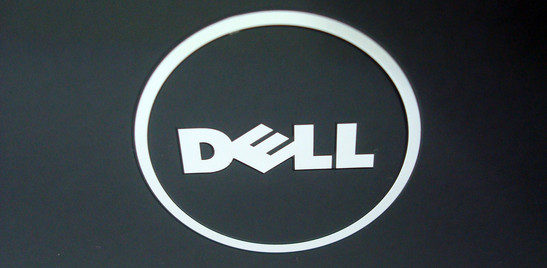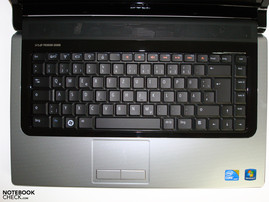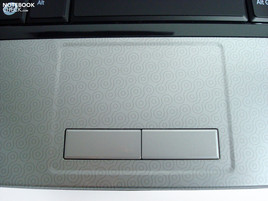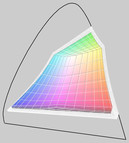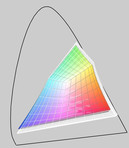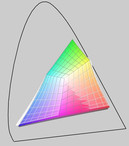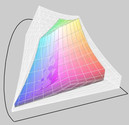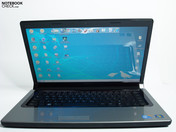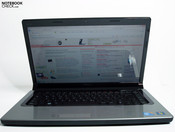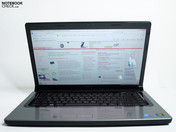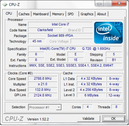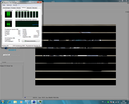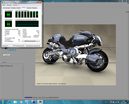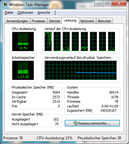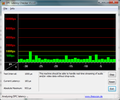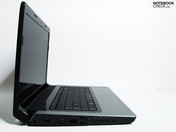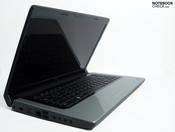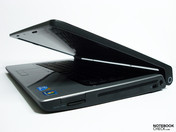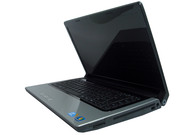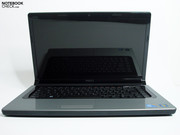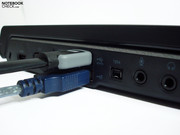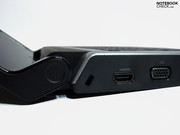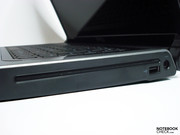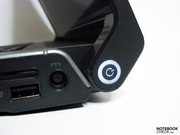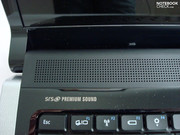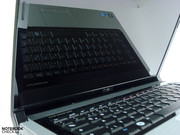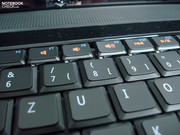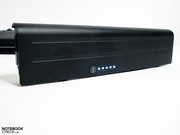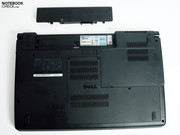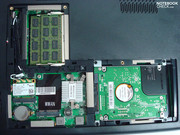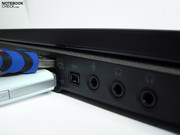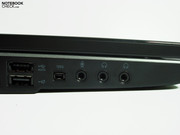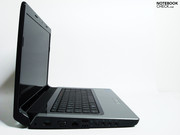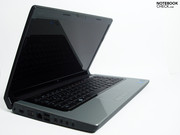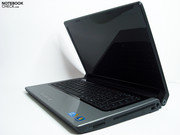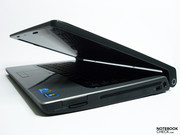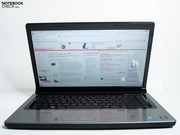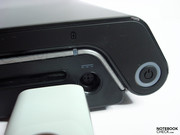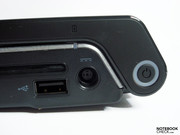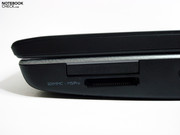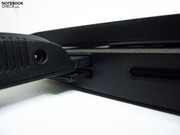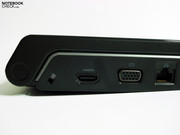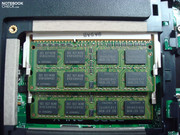Review Dell Studio 1557 Notebook
Processor Giant.
Slowly, Intel's brand new processor generation Core i7 is also advancing into current notebook series, and promises more performance with the same power consumption. The for some time already available Dell Studio 15 has now found its way to us with an Intel Core i7 Q720 CPU and has to prove just how much it can benefit from the new little computing power station in the following test.
Dell's Studio 15 represents the mainstream notebook in Dell's consumer portfolio, as it offers opulent configuration and individualization options to many users, aside from its already circumferential basic characteristics in the popular 15.6" category. Whilst you still have to live with starting class dual-core processors and an integrated Intel GMA 4500M HD chip set graphic in the basic configuration, the higher positioned model configurations can be equipped with a dedicated ATI Mobility Radeon HD 4570, a 7200 rpm fast hard disk and up to an Intel Core i7 820QM CPU. A FullHD display, up to 8 GB DDR3 RAM, BluRay, an 85 Wh battery and the various configuration options common for Dell can also be attained. Our model is equipped with the current Intel Core i7-720QM CPU, 4 GB DDR3 RAM, 320 GB hard disk and ATI Mobility Radeon HD4570 and already includes Windows 7 Professional 64 bit.
Case
The case of Dell's Studio 1557 prototype at hand is equal to the forerunner model, Dell Studio 1555, and accordingly doesn't have any novelties. The wedge-shaped straight design looks a bit massive but convinces with a solid quality and an extensive configuration. It's still within a good field with a size of 372mm (w) x 39mm (h) x 252mm (d) and a test weight of 2.6 kg (4.8 lbs). even for current standards.
As usual, the Studio 15 can be individualized according to taste and wallet size. Dell has a number of colors and designs to upgrade the display lid for a surcharge of 49 or 99 euro. If you don't want to make such an investment, then you will receive the standard color, Black Chainlink (high-gloss black with a faint structure), as can be seen on our item on loan. The silver colored wrist rest has a fine line and circle structure and slightly breaks up the interior look.
The easily twisted display lid and the connecting display hinges of the latest Studio aren't really convincing. They appear to be especially stable, but can't reach the desired stiffness in the end. Whilst the lid fulfills it protective function well - merely pressure applied to the frame provokes image distortions - the hinges have difficulties keeping the screen stable especially on moving ground. This isn't, of course, negative in stationary use as a desktop replacement and thus shouldn't be cause for restrictions. The hinges replace a separate closing mechanism for the display and base unit in a closed state as a side job and are completely sufficient for an occasional transport. The battery integrated in the rear doesn't sit quite as tight as known from other Dell notebooks, but shouldn't lead to disadvantages in most application fields. The Studio 1557 has a stable stance even with a removed battery because the support feet are placed on the rear left and right corner independent of the battery.
Connectivity
The sheer mass of various interfaces that you find on Dell's Studio 15 simply lets you rejoice. Even many considerably more expensive business notebooks can't keep up with this and are easily overtrumped by the Studio 15.
Aside from 2 conventional USB 2.0 ports (one with a charging function for MP3 players, mobile phones, etc.) that are suitable for usual peripherals like printers, digital cameras, memory sticks, etc., the test model additionally has an USB/eSATA combo connection. Both USB devices, as well as eSATA peripherals can be used here. eSATA has the advantage of supplying significantly higher transmission rates and is therefore predestined for connecting external hard disks. Video fans will be pleased about the existent Firewire port that many camcorders still have. An ExpressCard/34 slot for various extensions and directly underneath this, a cardreader for transferring smaller data volumes, such as digital pictures, has been placed on the right. You can use the analog VGA-out or a digital HDMI-out for image output. A gigabit LAN, a Kensington preparation and 3 audio ports (1x micro, 2x headphones) complete the picture and leave nothing else to be desired.
Our prototype bids WLAN in accordance to the fast n-standard and Bluetooth 2.0 as wireless interfaces.
The port distribution isn't quite as rejoicing. The ExpressCard/34 slot obstructs the cardreader at use. The USB ports don't like USB sticks with excess width because the DC-in as well as the slot-in drive gets in the way on the right. Both ports (USB and USB/eSATA) on the left have been placed on top of each other and cause a mutual blockage due to the small distance. It's recommendable to acquire an USB extension in any case, especially if USB extensions with excess width, such as UMTS sticks, TV cards, etc., are used.
The interface's transfer rates can be described as throughout good and usually supply over-average rates with 27.4 MB/s (USB), 71.4 MB/s (eSATA), 34.3 MB/s (Firewire 400) and 18 MB/s (SD/SDHC). The VGA output's signal quality was satisfying at a resolution of 1280 x 1024 and has an only slightly unfocused image.
Dell has comprehensive supplies as optional configuration features, as usual. BluRay drive or burner, backlit keyboard, up to 8 GB RAM, up to 500 GB hard disk memory and a FullHD display, just to name the most important ones. Support, warranty and service extensions can be added in a Dell-typical way.
Input Devices
Keyboard
The keyboard emits a somewhat louder key noise than usual, but isn't yet annoying. The good keyboard layout with an also good contrast-strong lettering bans the original F-key in the Fn area and allows special functions to be called upon directly. This feature, for instance, only reached across the visible area on Dell's Inspiron 11z, but didn't change anything about the actual alignment. Otherwise, the stroke, stroke length and stability are well-suitable for frequent typists.
Touchpad
The Dell Studio 1557 has a solid multi-finger suitable touchpad with smooth touchpad keys and good response. The gliding traits are good and the sensory surface is limited by a slight depression towards the wrist rest. The multi-touch gestures include the usual array, such as zooming, scrolling, etc. and are simple to use.
Display
The display built into Dell's Studio 1557 has an HD resolution of 1366x768 pixels (720p) and bids an aspect ratio of 16:9. The screen has a reflective surface (TrueLife) and is illuminated by an LED backlight.
Thus, the display resolution follows the latest trend, provides for slighter black bars with the current aspect ratio and achieves reduced power consumption with the LED technology.
The display brightness is far higher in the upper third center with a maximum of 232 cd/m2 than in the lower third center with an established 179.3 cd/m2. This results in an average brightness of 202 cd/m2 and a, especially for LED relations, rather average illumination of 77% with the other 7 measuring points. However, the brightness decrease is only visible on uni-colored display contents in daily work routine and shouldn't cause any restrictions in most cases.
| |||||||||||||||||||||||||
Brightness Distribution: 77 %
Center on Battery: 222 cd/m²
Contrast: 178:1 (Black: 1.25 cd/m²)
We find the low contrast ratio of 177:1 as very disappointing. This becomes especially obvious when the notebook is used for its conceived multimedia purpose, so movie rendering or when playing the one or other undemanding game. Black isn't black but only a gray black. The color space doesn't quite reach the sRGB standard but is a bit more extensive than in starter class standard notebook displays. This doesn't make a visible difference, though.
As in all other reflective displays, you must consider the surrounding light conditions a bit more. Set up adjacent to a window, directly radiating light sources or even bright clothing can cause strong disturbances. These mirror images can be outshined to a certain degree but they don't disappear completely.
These disadvantages prove to be even more adverse outdoors because the surrounding reflective items can't completely be outshone. Looking for a shadowy place turns into a compulsory exercise in to be able to even work close to satisfaction.
The viewing angle stability of the used display is on about an average level and allows image contents to be seen for quite a long time. Unfortunately, you have to already cope with partly strong color deviations at slight changes in position, which accordingly makes a frequent display readjusting necessary. As usual, the vertical field is more sensitive than the horizontal plane but has the advantage that the display angle changes can also be revised quickly.
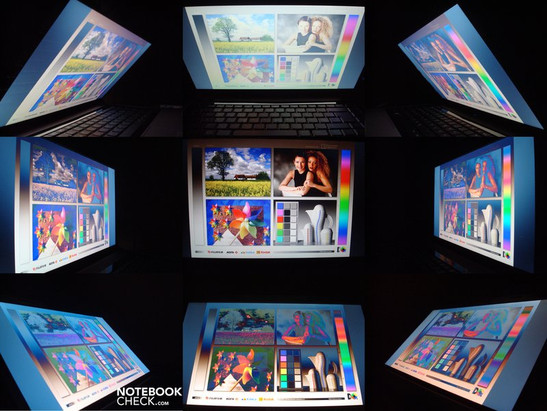
Performance
The heart piece, and therefore the main purchase reason, of our Dell Studio 1557 in the configuration at hand, is the built-in Intel Core i7-720QM CPU that can fall back on four computing cores.
The profoundest innovation of the current processor generation is the integrated DDR3 memory controller that is allegedly responsible for a significantly higher memory performance with a direct connection.
A further improvement should be achieved by the newly designed cache system. The level 2 cache has been notably reduced to 256 KB per core (total of 1MB), but is reimbursed by a 6MB sized level 3 cache at its side which all cores can use in a shared process.
Due to hyperthreading, not only 4 cores but 8 cores are displayed in the task manager, for example. Thus, every core has option of executing 2 threads at the same time at lower load, which increases the efficiency in accordingly lower loaded conditions.
The CPU bids the option of overclocking the regular rate for one core from 1.6 GHz up to 2.8 GHz when not all cores are used or if maybe even only one is loaded, with the Turbo Boost function. Programs that only use one core and don't have multi-core support benefit from this. On the other hand, the CPU can disable the cores or reduce the clock rate in order to decrease the power consumption at low load. We could establish a range of 930 MHz to 2800 MHz during our tests.
Dell still relies on ATI's Mobility Radeon HD4570 that has a dedicated 512MB GDDR3 graphic memory in regards to the graphic division. The core is clocked with 680MHz and the memory has 800MHz, but can adapt itself downwards depending on the load. The main weak point of the used graphic card, in comparison to the HD4650, is the memory bus reduced to 64bit.
The potential of the 4 core CPU 720QM is finally displayed in our benchmarks. Our prototype achieved 3658 points with only one core in the Cinebench R10 rendering and is therewith on the same level as, for instance, a Core 2 Duo T9900 CPU with a 3 GHz rate. Thus, the multi-core advantage doesn't turn out quite as big in the multi-core rendering (multi-core speedup of 2.65), but is noteably in front of other 2 core opponents with a lead of about 2500 points and can especially beat its forerunner, Intel's Core 2 Quad (2386 single/8267 multi) obviously. Our MP3 track converted the 1 core optimized iTunes with a 30.3-fold velocity into the AAC format and takes a big lead on e.g. the Thinkpad T400s' SP9600 CPU (2.5 GHz), which only reached a 26.6-fold velocity.
With this, the new processor generation, in particular with the turbo boost function, achieves a felicitous straddle to supply 1 core optimized programs, as well as multi-core operated software with the best possible efficiency depending on their requirement.
The graphic unit, Mobility Radeon 4570, barely benefits from this. 4511 points in Cinebench R10's OpenGL rendering are 700 points more than in the Studio 1555's test but in return, the 3DMark rates turn out a bit poorer with 3480 ('06) and 1041 (Vantage) (Studio 1555: 3735/1168). Whereas you have to consider that Windows 7 and the correlating drivers are still very fresh and therefore the true efficiency isn't necessarily reflected.
FullHD videos can be rendered smoothly with and without GPU support. Office, Internet, image editing and video editing aren't a problem for the Studio 15 and are completed quickly. We refer to the PCMark Vantage result of a very good 5426 points. The system seems to also have enough reserves for simpler 3D CAD construction tasks, but difficulties have to be counted with due to non-optimized drivers and graphic hardware. If you have ambitions in this field, you should rather take a pro-solution, such as Nvidia's or ATI Fire GL.
| PCMark Vantage Result | 5426 points | |
Help | ||
| 3DMark 03 Standard | 8626 points | |
| 3DMark 05 Standard | 6210 points | |
| 3DMark 06 Standard Score | 3480 points | |
| 3DMark Vantage P Result | 1041 points | |
Help | ||
As already established in Dell's Inspiron 13z, the Studio 15 also has a 2.5" hard disk that works with a rotation velocity of 7200 rpm. It comes from Western Digital and has a capacity of 320 GB. It works almost 10 MB/s faster than most colleagues with 5400 rpm with an average transfer rate of 64.6 MB/s and demonstrates a pleasant performance gain with that. The disk can't keep up with current SSDs but bids considerably more memory space/euro.
As already mentioned, the employed ATI HD 4570 suffers especially under the 64bit memory bus. The efficiency is enough for most of the tested games anyway, if you're willing to take cutbacks in view of resolution and/or image display. You can also expect a somewhat better result in the native display resolution of 1366 x 768 pixels than what is shown in the 1280 x 1024 resolution applied in a few tests. Only Need for Speed Shift is to be viewed as marginal because even minimum graphic details at a minimum resolution of 800 x 600 in our tour through London caused sporadic jolts and the game only is fun for a short time.
| Need for Speed Shift | |||
| Resolution | Settings | Value | |
| 1366x768 | all on/high, 4xAA, triliniarAF | 11.7 fps | |
| 1024x768 | all on/med, 2xAA, triliniarAF | 21.3 fps | |
| 800x600 | all off/low , 0xAA, triliniarAF | 27.9 fps | |
| Anno 1404 | |||
| Resolution | Settings | Value | |
| 1280x1024 | very high, 0AA, 4AF | 8 fps | |
| 1024x768 | low, 0AA, 0AF | 50.9 fps | |
| World of Warcraft | |||
| Resolution | Settings | Value | |
| 1280x1024 | high | 10.9 fps | |
| 1024x768 | med | 56.9 fps | |
| F.E.A.R. 2 | |||
| Resolution | Settings | Value | |
| 1280x1024 | high, all on, 4xAA, biliniarAF | 15.2 fps | |
| 1024x768 | medium, all on, 2xAA, biliniarAF | 35.8 fps | |
| The Elder Scrolls IV - Oblivion | |||
| Resolution | Settings | Value | |
| 1280x800 | max, HDR, 0xAA, 16xAF | 40.5 fps | |
| Call of Duty 4 - Modern Warfare | |||
| Resolution | Settings | Value | |
| 1280x1024 | high, 4xAA | 24.1 fps | |
| 1024x768 | med, 0xAA | 37.1 fps | |
| Sims 3 | |||
| Resolution | Settings | Value | |
| 1024x768 | med / all on | 33.8 fps | |
| 800x600 | low / off | 133.5 fps | |
Emissions
System Noise
One of the darker chapters in our review is the noise development field. The Dell Studio in the quad-core configuration is always existent with 34.6 dB(A) and could already be too loud for sensitive ears with its persistent noise. At least the fan's frequency stays constant even under load and doesn't disturb with additional frantic changes in the fan's rotation. The hard disk noise is even a bit over the basic situation with 35.4 dB(A) and therefore also audible.
The fan and drive noise with DVD rendering add up to a very annoying 38.4 dB(A), which have to be drowned by an according soundscape.
When the Studio 15 is then used for which the i7-720QM CPU is best suitable, the 44.1 dB(A) are already disagreeable after a short period and tear unduly on nerves. This point makes it obvious that the employed CPU with a TDP of 45 watts needs quite a lot of power for notebook conditions and brings the cooling possibilities to the borders of the impossible.
Noise Level
| Idle |
| 34.6 / 34.6 / 34.9 dB(A) |
| HDD |
| 35.4 dB(A) |
| DVD |
| 38.4 / dB(A) |
| Load |
| 44.1 / 44.1 dB(A) |
 | ||
30 dB silent 40 dB(A) audible 50 dB(A) loud |
||
min: | ||
Temperature
Whilst the temperatures at low load benefit enormously from the CPU and GPU energy savings technology (disabling single cores, clock rate reduction) and remains fairly cool on the bottom with selectively 43.3°C, and an average of about 34°C otherwise, the picture looks considerably worse under load.
Then the temperatures on the bottom, in five of nine measuring points, move slightly under or over the 50°C mark, despite the fan running constantly with a high velocity. The Studio 15 even reaches 58.6°C selectively in the center and gets very hot there. A sufficient circulation should, therefore, always be assured to not additionally burden the system.
The maximum temperatures of around 45°C in the keyboard area are still acceptable and usually shouldn't cause any unduly restrictions. Especially the wrist rests stay pleasant with a maximum of 38.1°C.
(-) The maximum temperature on the upper side is 45.6 °C / 114 F, compared to the average of 36.9 °C / 98 F, ranging from 21.1 to 71 °C for the class Multimedia.
(-) The bottom heats up to a maximum of 58.6 °C / 137 F, compared to the average of 39.2 °C / 103 F
(±) The palmrests and touchpad can get very hot to the touch with a maximum of 38.1 °C / 100.6 F.
(-) The average temperature of the palmrest area of similar devices was 28.8 °C / 83.8 F (-9.3 °C / -16.8 F).
Loudspeakers
The loudspeakers sound quite agreeable for notebook conditions, but they have their problems to reach the user over a higher fan rotation. The rather balanced pitches with a good maximum volume are slightly treble-prone and leave you missing a bit of a "bang", especially in movies. They do a good job for most other demands, though. But it's recommendable anyway to use headphones or more efficient speakers, as already mentioned in the beginning, to drown out the partly loud fan noise, particularly at gaming or DVD rendering.
Battery Life
The prototype has a smaller 56 WH battery that can be replaced by a bigger model with a capacity of 85 Wh during the order process. Dell currently takes a surcharge of 85 euro for it and is supposed to ensure a battery life extension of about 50%.
Despite strong components, the minimum power consumption stays agreeably in lower fields with a minimum of 18.5 watts and is to be ascribed in particular to the Intel Core i7-720QM CPU's energy savings functions, aside from the LED display and ATI's Powerplay. This has received the capability to both reduce the clock rate, as well as to simply disable whole cores at minor load. The power consumption without load increases to 20.9 watts in a balanced energy profile. At maximum performance, and still without load, it rises to 25.6 watts.
The power requirement rockets to an enormous 73.8 watts at medium load in high performance profile and all consumers enabled. The system turns up even more at maximum load and treats itself to 90.2 watts. This seems to be even too much for the adapter because it heats up to a too hot to touch 82.6°C in this condition.
For the runtimes this means that a usable battery life is very well possible at lower load. The prototype reached 254 min of mains independency in the BatteryEater Reader's test (maximum possible runtime with maximum energy savings settings). It came quite close to the 3 hour border with 164 min at WLAN surfing. You don't have to worry much while watching a DVD, at least with normal lengths, as it achieves 136 min. In the BatteryEater Classic test (minimum possible runtime under load and all consumers enabled), the runtime decreases to a poor 58 min as expected and barely allows the Studio 1557 to be used for its purpose.
| Off / Standby | |
| Idle | |
| Load |
|
Key:
min: | |
Verdict
The Dell Studio 1557 with Intel's Core i7-720QM processor is interesting for everyone who needs a high measure of processor performance. Both one-core, as well as multi-core software benefit from the new processor generation. In view of this, the current price also seems to be very low in relation to performance, which is very attractive for the complete package at hand.
However, potential buyers should be aware that the emissions take their toll with a peeving soundscape within a short time and partly alarming temperatures moving in a marginal field.
Above that, the basically good manufacturing quality suffers under the somewhat instable display lid and the not quite so tightly gripping hinges.
The graphic performance is sufficient for occasional gamers with low demands and manages all other usual multimedia tasks more than sufficiently.
The connectivity is exemplarily circumferential, but suffers again under a partly unpractical distribution.
Unfortunately, improvements on the used display, in comparison to the Studio 1555 reviewed last, couldn't be established. Particularly, multimedia fans will be upset about pallid colors and low contrast values. The effects of the reflective surfaces can be reduced indoors but prevent an intended outdoor usage.




